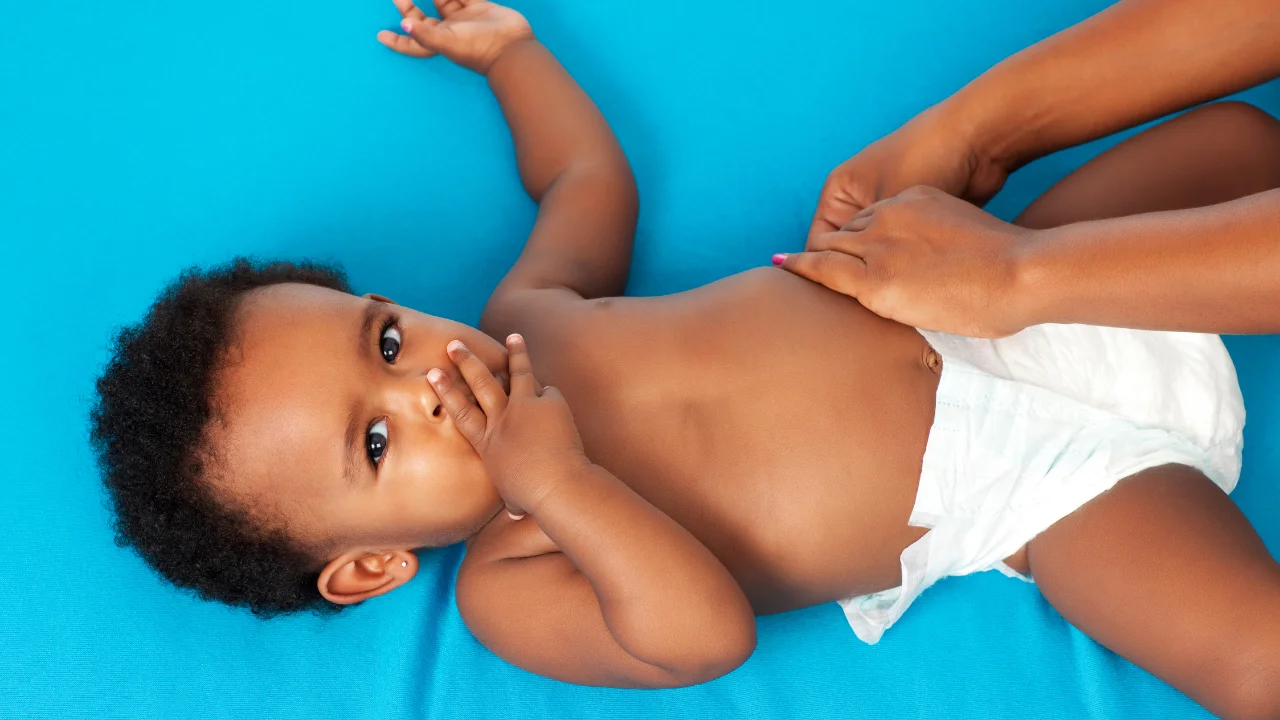
IN THIS ARTICLE
- What’s in a disposable diaper?
- Are the chemicals in disposable diapers safe?
- What do pediatricians say?
- What parents can do
It’s hard to imagine life without disposable diapers. After becoming widely available in the late 1960s and early 1970s, disposables are now the norm in much of the world – and for good reason. There’s no denying that throwaway diapers are a major convenience for many parents.
Disposables are such a given, in fact, that few wonder what they’re made of. But it’s a reasonable question for a product that spends so many hours in direct contact with your child’s most sensitive areas. What’s really in disposable diapers, and could those materials could harm your baby?
What’s in a disposable diaper?
While disposable diapers seem simple, they have more materials and parts than you might think. Diaper companies aren’t required to list what’s in their product on the packaging, but most modern disposables follow the same basic model:
The outer lining
The outer lining is usually made of polyethylene film, essentially the same stuff that’s in plastic wrap. (Some diaper use a bioplastic instead, made from renewable resources such as vegetable oil instead of petroleum.) The inner lining that touches your baby’s skin is usually made of polypropylene, a common material that’s also found in thermal underwear, among other things.
Both materials are considered completely safe for young skin. Some brands enhance the inner lining with aloe and vitamin E, skin-friendly compounds often found in diaper rash creams.

The absorbent core
A disposable diaper’s absorbent center contains wood pulp (usually bleached white with chlorine) and super-absorbent polymers, usually sodium polyacrylate – a compound that can soak up to 30 times its weight in urine. When introduced in the early 1980s, it allowed diapers to become both thinner and more effective at keeping babies dry.
Sodium polyacrylate is supposed to stay in the core of the diaper. But sometimes it leaks through the lining, leaving small transparent crystals on the baby’s skin.
Dyes
The cartoon characters and other images on the outside of many diapers are made with dyes such as Disperse Blue 106, Disperse Blue 124, Disperse Yellow 3, and Disperse Orange 3. Dyes may also be used in the elastic in back, in wetness indicators, and around the legs.
Scents
Scented diapers contain a small amount of perfume between the absorbent core and the outer layers. The perfumes typically contain citral, a citrusy-smelling compound often found in lemon and orange oils.
To avoid any of these ingredients, look for diapers that are dye-free, perfume-free, chlorine-free, and so on. They’re readily available for sale. Look for details on the packaging.
Are the chemicals in disposable diapers safe?
Sodium polyacrylate: According to various material safety data sheets the sodium polyacrylate in diapers is mild stuff. Inhaling small particles might irritate the airways, but it’s considered nontoxic.
Sodium polyacrylate itself is not irritating to the skin. And because it’s a polymer, it sticks together in long chains that are way too large to be absorbed through the skin. However, sodium polyacrylate is sometimes mixed up with small amounts of acrylic acid, a leftover from the manufacturing process.
In theory, acrylic acid in large doses could be harmful to a baby’s skin. But according to a 2009 report in the Journal of Toxicology and Environmental Health, there isn’t nearly enough acrylic acid in disposable diapers to raise concern. (The study was funded by Procter & Gamble, a major manufacturer of diapers.)
People who warn against the dangers of disposable diapers often say that sodium polyacrylate can cause allergic skin reactions. Fortunately, such reactions seem to be very rare. A 2008 report in the journal Clinics in Dermatology cited only one case of a possible allergic reaction to sodium polyacrylate, and that was in an adult using an incontinence pad. The authors note that very few babies have allergic reactions to anything in their diapers.
In the late 1970s and early 1980s, hundreds of women using super-absorbent tampons containing sodium polyacrylate developed toxic shock syndrome, a potentially fatal disease caused by bacterial infections. When sodium polyacrylate first started showing up in diapers, some people worried that babies could get toxic shock syndrome, too. But that fear turned out to be unfounded. A diaper worn on the outside of the body is far different from a tampon, and no case of a diaper causing toxic shock syndrome has ever been reported.
Dyes: The dyes used in diapers are generally safe. But in rare cases, some of them have triggered allergic reactions in babies.
Perfumes: Some babies are sensitive to citral and other perfumes in diapers, although actual allergic reactions seem to be uncommon.
Dioxins: The wood pulp in diapers gives them a little extra cushioning and absorbing power, but it can also introduce other potentially worrisome chemicals, namely dioxins. This family of chemicals, created when wood pulp is bleached with chlorine, is known to cause cancer in humans.
Most disposable diapers carry tiny amounts of dioxins. Some worry that the dioxins found in disposable diapers that have been thrown away will contaminate groundwater near landfills. Parents, of course, have an additional worry.
There doesn’t seem to be enough dioxin in a diaper to threaten a baby’s health, however. In fact, it’s not even a close call: A study published in the in 2002 estimated that kids get thousands if not millions of times more dioxins in their diet than they get from their diapers. (Dioxins are everywhere in the environment, and they end up in everything that we eat, especially animal fats.)
The study also found that the most dangerous types of dioxins – the forms most likely to cause cancer and other disease – don’t show up in diapers at all.
What do pediatricians say?
In general, pediatricians and other experts say that disposable diapers do what they’re supposed to: protect babies’ skin without much mess, hassle, or reason for worry.
What parents can do
If a particular diaper seems to be causing problems for your child, try switching brands recommends the pediatric dermatologist. You can also try switching to cloth diapers, which are less absorbent but are free of dyes and many of the chemicals found in disposable diapers.
To treat a mild diaper rash, pediatric recommends the standard approach: Change your child often, making sure the skin is dry before using a skin protecting cream or ointment and putting on a fresh diaper.
For a more serious rash, be sure to check in with your child’s doctor.
Read more about


Add a Comment